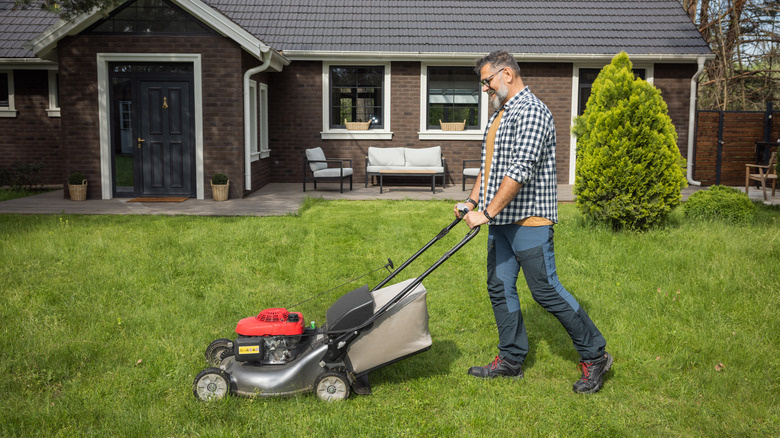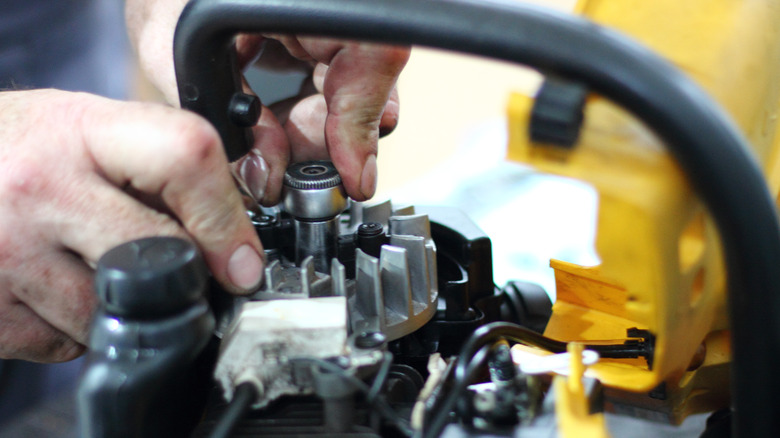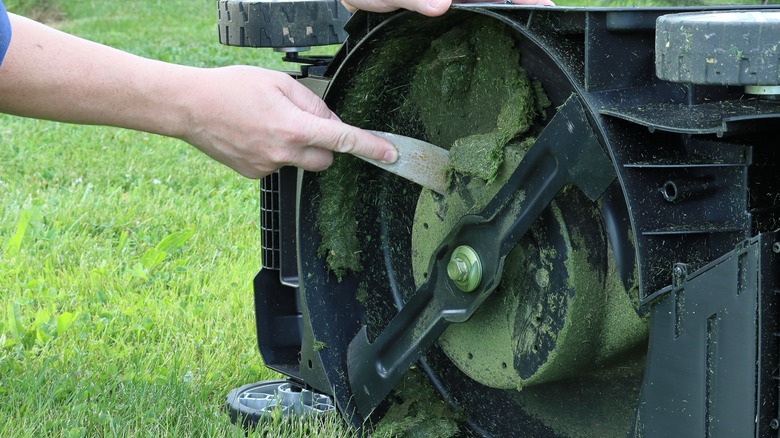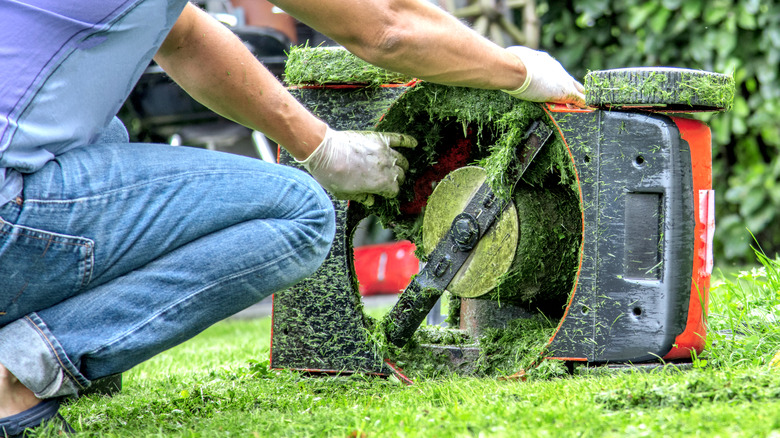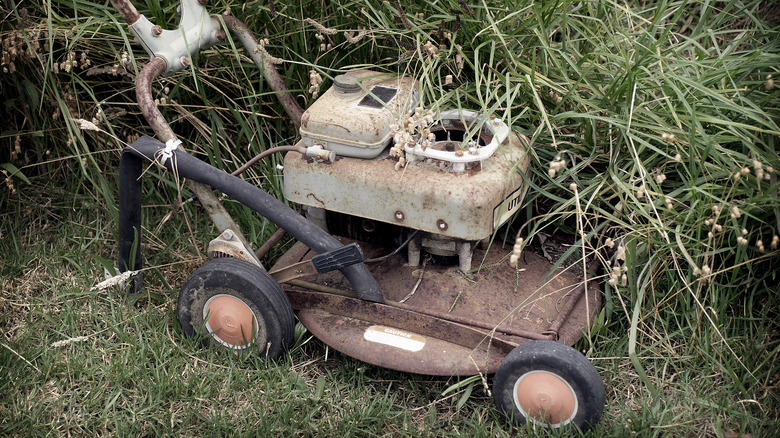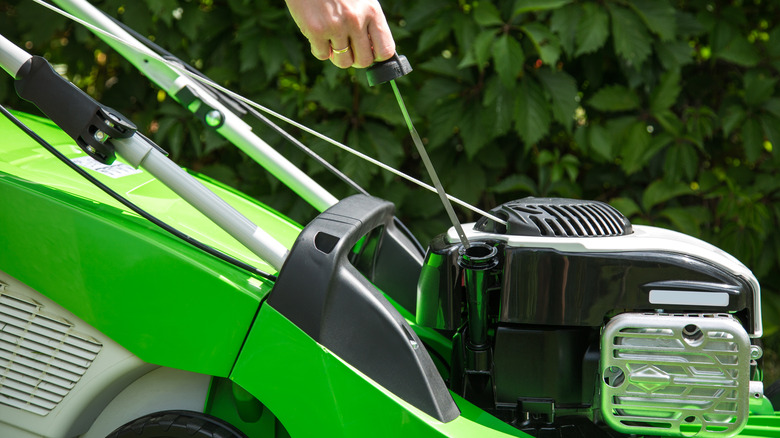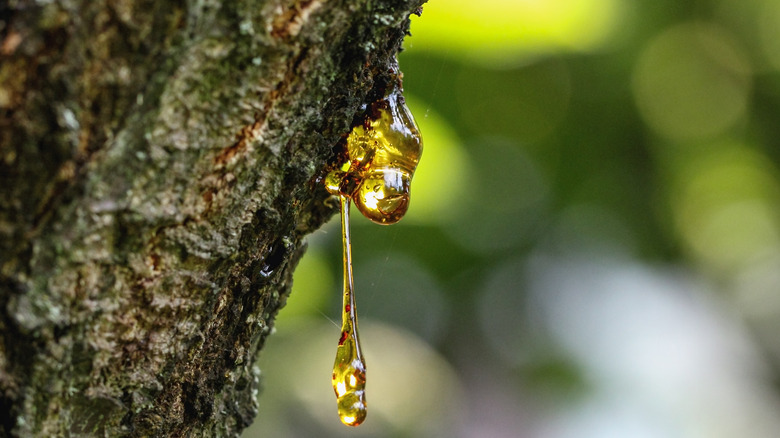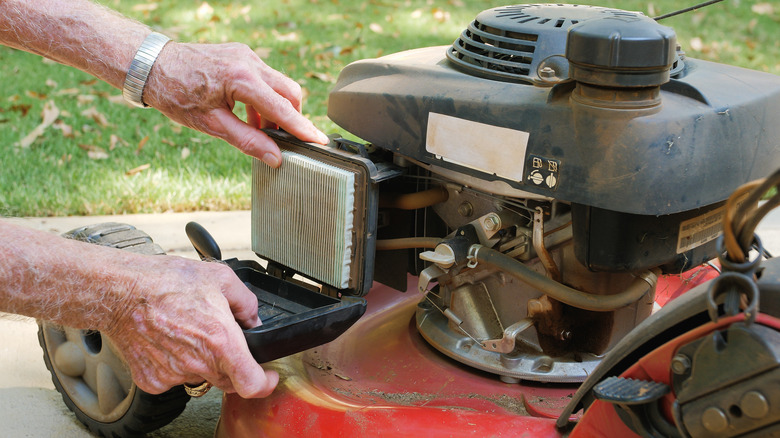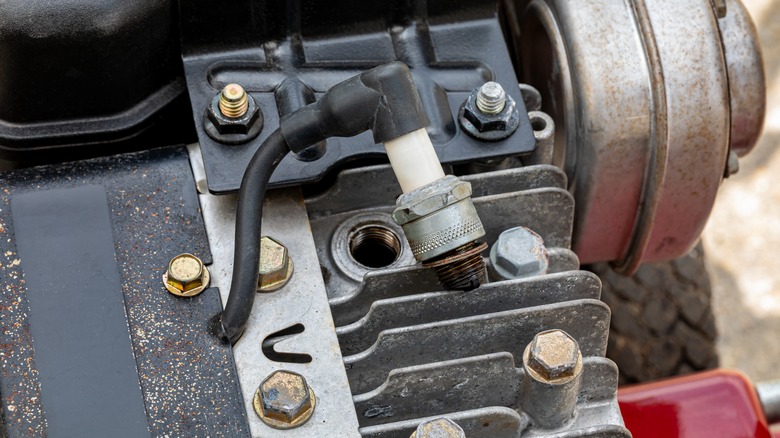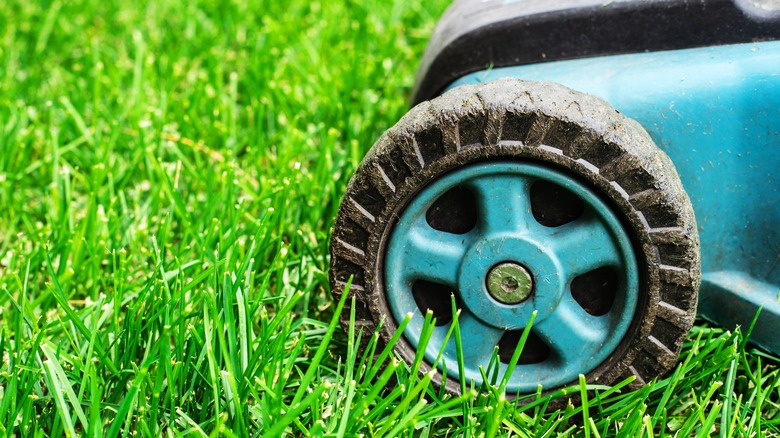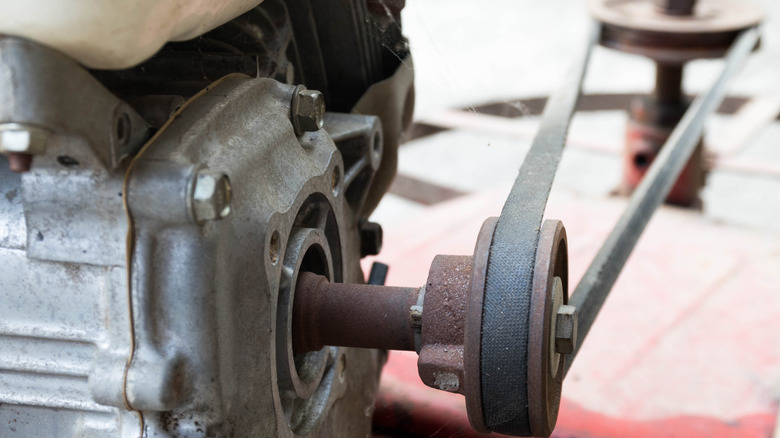Here Are All The Ways You Can Use WD-40 To Get The Most Out Of Your Lawn Mower
Unlocking the full potential of your lawn mower involves more than just regular mowing and occasional maintenance. Potentially surprising to some, household hero WD-40 can be used in a myriad of ways, not only to keep the machine running smoothly, but also to extend the life of the lawn mower. Incorporating this versatile product will result in a much more enjoyable mow, as less effort will be needed to complete the chore.
From lubricating crucial components, such as the throttle and wheel bearings, to protecting against rust, you'll find WD-40 is an indispensable tool in getting the most out of your lawn mower. It's also extremely affordable, as the contents of one can go a long way, and it's easy to use. It's important to note, though, that WD-40 is not a long-term lubricant. If prolonged lubrication is required, consider using a specialized lubricant after the initial use of WD-40. Check the lawn mower's owner's manual for recommendations. In the meantime, here's how to use WD-40 on your lawn mower.
Lubricate moving parts
Although WD-40 is a multi-purpose product, one of its main functions is to provide lubrication to a machine's moving parts. Lubricating various parts of your lawn mower improves efficiency and ensures the machine operates smoothly. WD-40 specifically lists the following parts as approved for use with their lubricant: lawn mower control cables, drive belt pulley bearings, the drive pulley of the lawn mower blades, external pivots, and the throttle cables. Additionally, the company points out that WD-40 lubricates the speed control cable on power mowers, as well as the steering mechanism on riding lawn mowers.
Once you locate the lawn mower's moving parts, make sure they are clean of debris. Brush off any dirt or wipe away the grime. Next, give the WD-40 a little shake and begin spraying the parts you need lubricated. You want the coverage to be even, so hold the can about 6 inches away from the area you need to spray. The important thing to remember is to not apply WD-40 to any area of the lawn mower that needs traction. Wait a few minutes for the lubricant to penetrate the part before cleaning up any excess fluid with a rag.
Clean the deck and the blades
Another approved use for WD-40 is to remove gunk from a lawn mower's deck and blades. As you mow, dirt, mud, and grass clippings can stick to the underside of the mower's deck, as well as the blades, especially if the grass is still a bit wet. This makes the blades less effective, and if the gunk isn't removed, it may get so clogged that the blades no longer rotate at all. The WD-40 works to aid you in cleaning your lawn mower by softening and releasing the dirt and grime.
To clean the deck and blades, you must first turn the mower off and disconnect the spark plug wire. Remove as much of the loose dirt as you can with a brush or scraper. Give the WD-40 can a shake and coat both the blades and deck evenly with the liquid. Let it sit for several minutes — this gives the WD-40 time to penetrate the grime. Removing the rest of the dirt should now be effortless using just a brush and an old rag. Reattach the spark plug wire and you're good to go!
Stop grass from sticking to the blades
Once your lawn mower blades are clean, you can coat them with a little WD-40 to keep grass cuttings from sticking the next time you mow. The solution works to make the surface of the blades slippery, ensuring that cuttings slide off the blades and back down to the ground. Taking this step also reduces how often you'll have to stop to clean out the deck and blades in the future, saving you time and energy in the long run.
To use WD-40 to repel grass, you'll first need to wipe down the blades with a rag (unless you just finished cleaning them). Hold the can approximately 6 inches away and begin spraying the blades. You want to coat them completely, and WD-40 reports that it's okay to use excess lubricant on the blades. Wait a few minutes before wiping away any solution that dripped off of the blades. Repeat the process after each cleaning.
Prevent rust and corrosion
Back in 1953, WD-40 was created by the Rocket Chemical Company because the aerospace industry needed a way to prevent rust on missiles. Today, this handy product continues to be used to stave off rust and corrosion on a host of machines, including the metal parts of a lawn mower. In fact, the "WD" in WD-40 stands for "Water Displacement." Water is what causes rust to form. The WD-40 solution displaces that moisture, thus eliminating the conditions needed for rust and corrosion to occur.
Ensure the lawn mower has been cleaned and thoroughly dried before you begin. Apply WD-40 to all of the lawn mower's metal surfaces, spraying at a distance of 6 inches. Wait a few minutes before wiping up any excess fluid. Since WD-40 doesn't offer prolonged protection, you'll need to reapply it every so often to continue to prevent rust from forming on your lawn mower and its parts.
Release stuck parts
Making lawn mower repairs is difficult when certain parts of the machine are stuck on so tight that you can't remove them. Loosening stuck parts, such as rusted nuts and bolts, is another way you can use WD-40 to get the most out of your lawn mower. In fact, releasing stuck parts is even included on the company's website as one of the many approved uses. This is because the solution penetrates and lubricates machine parts, making them easy to manipulate. Getting the parts released, completing the necessary repairs, and replacing parts no longer requires a great deal of elbow grease.
When making repairs, turn off the lawn mower and disconnect the spark plug wire. Locate the parts that are stuck and spray WD-40 directly into them. You'll need to give the lubricant time to seep into the joints, cracks, and crevices. Every few minutes you can give the part a gentle tug to see if it's ready to come loose. If not, wait a little bit longer. Apply a second round of WD-40 to parts that are more difficult to remove. Complete your repair, reattach the parts, and plug the spark plug wire back in.
Remove sticky residue
Dirt and grass cuttings aren't the only things that can plague a lawn mower. Sticky residue from tree sap may also cling to your machine. Sap is not easily removed with soap and water; however, WD-40 is made using a formula that breaks the chemical bonds that keep sticky substances glued to your mower. This means you can use it to release the sap, which, left on the machine, will trap leaf mulch, dirt, grass clippings, and more.
First, remove as much of the sap as you can using a microfiber cloth. Spray the WD-40 directly over the sap and wait 10 minutes for the solution to break down the bonds that are adhering it to your machine. Grab a clean cloth and wipe away the sticky residue and remaining WD-40. If the sap is thick, you may need to repeat the process to successfully remove all traces of the sticky substance.
Tip: You can use WD-40 to eliminate all kinds of sticky residue, including that left behind by duct tape, stickers, and pure maple syrup.
Repel dust from around the air filter
Part of a homeowner's regular lawn mower maintenance involves changing out the air filter. The next time this task is on your list, grab a can of WD-40, as this versatile product can also be used to keep dust from accumulating around the air filter. Repelling dust helps keep the filter from becoming clogged, which not only affects the engine's power, but also results in the machine using more fuel than it would otherwise need.
Remove the old air filter and dispose of it properly. Next, clean the area to remove any current dust and debris. You can do this using a microfiber cloth, or a brush if needed. Once you have a clean surface, spray the area with WD-40. Remember to hold the can about 6 inches out and apply an even coat for best results. Wait a few minutes before installing the new air filter. Repeat the process any time you need to swap filters, which experts recommend doing every 25 hours of running time.
Displace moisture from the ignition system
As we learned earlier, WD-40 is used to displace water. Displacing moisture from a lawn mower's ignition system is crucial because water can interfere with the proper functioning of the ignition components. The engine's fuel-air mixture can't be ignited without a spark, and you won't get a spark if there is water in the ignition system. Applying WD-40 eliminates and repels the water so that the system can operate as intended.
In the event that your lawn mower was left out in the rain, get it as dry as possible using a leaf blower. You can also set it out in the sun and wait for the moisture to evaporate, but this will take more time. Make sure the lawn mower is turned off and the spark plug wire is disconnected. Next, spray the ignition switch, spark plug wires, spark plug boots, and all of the other electrical connections with WD-40. Wait a few minutes for the solution to do its thing and then wipe up any excess fluid. Reinstall the spark plug wire and the mower is ready for use.
Tip: WD-40 reports that you can also spray the product directly into the carburetor if the engine gets flooded.
Remove scuff marks and shine tires
WD-40 can also be used to remove scuff marks and shine tires to keep your lawn mower looking as good as new. While this isn't necessary for the machine to operate at peak efficiency, it keeps the mower aesthetically pleasing, which is especially important if you're getting the lawn mower ready to sell.
After you've had a chance to clean the mower, grab a can of WD-40 and give it a shake. Spray the solution directly over all of the scuff marks you come across. Let the formula sit for several minutes before wiping it away, along with the scuff marks, using an old rag. Next, move on to the tires. Apply the WD-40 to outer parts of the tires to give them a nice shine. Don't spray the solution on the tread, as this will remove the traction needed to operate the mower.
Reduce friction on the belts and pulleys
Applying WD-40 to a lawn mower's belts and pulleys will reduce friction to keep the parts running smoothly. This is important for many reasons. Too much friction can cause the parts to squeak, which can be quite annoying to listen to as you mow. Additionally, the entire system may even seize up if the problem is severe enough.
Take advantage of WD-40's lubricating properties and spray it on the belts and pulleys after you have shut off the machine and disconnected the spark plug wiring. Coat the surface evenly at a distance of 6 inches and rotate the belts and pulleys as you go, as this will get the WD-40 through the entire system. Wait a few minutes before cleaning up any excess solution. Reattach the spark plug wiring and resume mowing your landscape. You can reapply the WD-40 any time you hear a squeak, or simply lubricate the parts at the beginning of each mowing season.

